|
TYSZKOWSKI GROUP PHOTOS
PAGE 6
IZRAEL
MOSZK KOWALSKI, LEJA LINENBERG AND FAMILY
|
Photo 03-06-01
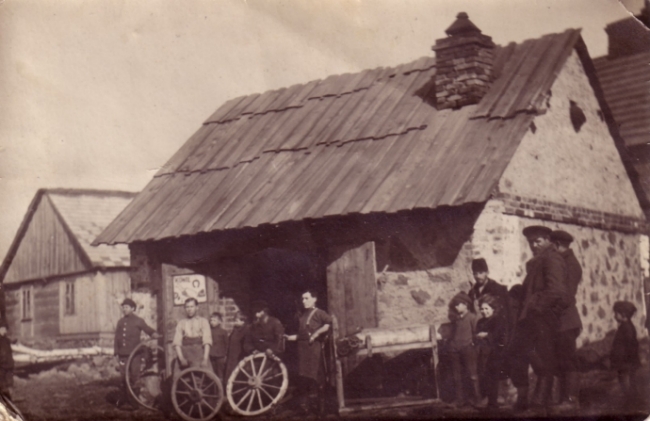
|
|
The
Kowalski family blacksmiths' forge
Nadstawna Street,
Radzilow, mid-1920s
This photo of the forge was
probably taken in the mid-1920s, when it was run by Mejer Kowalski, one
of a number of family members who shared the name. He can be seen in the
doorway of the forge, to the right of the bearded man who is holding the
wheel. Mejer would have inherited the forge from his father, Izrael
Moszk Kowalski, who died in 1900. However, it is likely that one of
Izrael Moszk's several blacksmith brothers would have run the business
immediately following his death, as Mejer was only a child when his
father passed away.
The reverse of the photo
bears a lengthy Yiddish inscription written by Mejer to his sister,
Szejna Rajchel, who emigrated to New York in 1921. He laments the fact
that the forge was not situated on his own property, and announces his
decision to leave Radzilow. The photo was taken as a souvenir of the
family's life in Radzilow. Mejer emigrated to Israel with his wife and
son, c.1924.
|
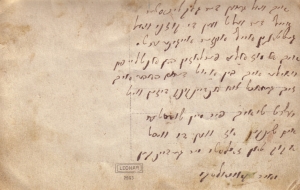
|
|
Yiddish
inscription reads:
"Ich wott gewen der glicklichste oif der welt wenn
die kusni wot gestannen oif inser eigene ert. Ich
miss alle ferlosen in entloifen Ich bin seit ... Ich
sich .... Zim andeinken .... Ti ich far mein
shvester im shenken As wen di west a kik ton,
sollste mir gedenken.
Meir Kovalsky"
"I would have been the happiest man in the world if
the forge had stood on our own land. I must leave
everyone behind and run away because I am a Jew
(?). Therefore, I have made this greeting as a
memento, which I do for my sister as a gift to her,
that when you take a look at it, you should remember
me.
Meir
Kowalski"
|
|
Photo donated by Robin Kavall. This
translation is a combination of translations by Esriel Sternbuch and
Michele Zoltan, edited by Saul Marks. |
|
|
Photo 03-06-02
|
Photo 03-06-03
|
|
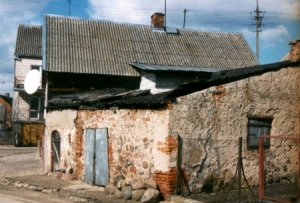
|
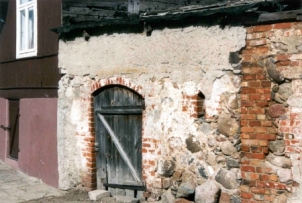
|
|
The remains of the Kowalski
forge, March 2003
These photos were taken by Keith Juzba, who is unrelated to the Kowalski
family, but whose ancestors also came from Radzilow. Although, at first
glance, this tumbledown building does not look like the building in the
1920s photo, above, it has been confirmed as the former Kowalski forge
by a local resident.
There are a number of significant changes which have been made to this
small building between the 1920s and today. Firstly, it can be seen from
the left-hand photo that the building has been attached to the back of a
two-storey house, the front of which faces onto the street in the
background, Lomzynska Street. As the house does not exist in the earlier
photo, it must have been built in the interim, although its style
suggests a date of construction earlier in this period, rather than
later. Lomzynska Street is at an angle of rather more than 90° to
Nadstawna Street, on which the forge stands. The house in the background
of the earlier photo, if it still stands today, would be on the far side
of Lomzynska Street, near the site of the shul.
In
comparing the side wall of the forge in the 1920s photo with that in the
left-hand photo from 2003, it is clear they are very different. The
later photo shows the wall with a small window in it, and it has been
covered with some form of plasterwork. It also appears that roof of the
building in the 2003 photo rises at a much shallower angle than that in
the earlier photo. The combination of these two facts suggests that the
forge had had its side wall knocked down and a longer one rebuilt, with
the window in it. The exposure of the brickwork underneath the plaster
at the corner of the building shows the thickness of the new wall.
The type of stone seen on the front of the building in the 2003 photo is
seen to be very similar to that in the 1920s photo, so it is reasonable
to assume that the front of the building is the same as that in the
earlier photo. There is certainly no doubt that this type of material
would have been able to withstand the intense heat generated by the
blacksmiths' work.
It
appears that the doorway in which Mejer Kowalski is seen in the 1920s
photo is that which is covered by the blue doors in the 2003 photo.
However, the arched doorway featured in the right-hand of Keith Juzba's
photos could also be the original doorway to the building. The left-hand
photo strongly suggests that this building is, in fact, two conjoined
buildings, each with a separate entrance. Despite this, it is still
impossible to determine which is the doorway shown in the 1920s photo.
Both the older and newer photos show the slight slope of the ground
towards and beyond the front of the forge building, towards the left
foreground. This slope continues, out of shot, down to the Biebrza
river.
|
|
|
|
Photo 03-06-04
|
Photo 03-06-05 |
|
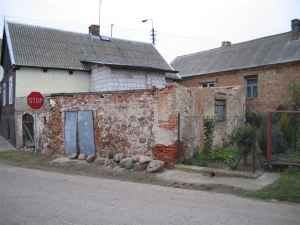
|
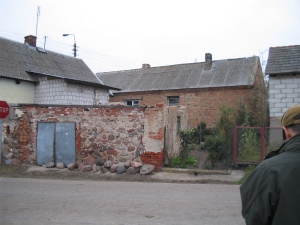 |
|
The remains of the Kowalski
forge, 16 October 2004
These photos were taken by my cousin and research partner, Jeff Kaiser,
on his visit to Radzilow. In the 19 months since Keith Juzba's visit,
the roof of the forge building had collapsed or been demolished and the
stop sign added (though it is unknown why the sign should be in
English!).
These photos also show the length of the side wall of the forge, and it
seems the roof depicted in the 2003 photo was single-sided, not sloped
on both sides, as in the 1920s photo. This suggests the rear wall of the
forge had been rebuilt or extended upwards to accommodate the new shape
roof. The angle between the front wall of the forge building and the
side wall of the house can clearly be seen in the left-hand photo.
By
the time these latest photos were taken, it was clear that the forge
building is no longer in use even by the inhabitants of the house to
which it is attached. The area enclosed within the remaining walls may
be used as a storage area, but the absence of the roof highlights the
instability of the building's remains. An example of this is the hole in
the building's front wall, next to the stop sign!
|
|
Photos donated by Jeff Kaiser |
|
|
|
Photo 03-06-06 |
|
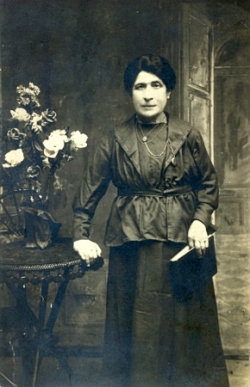
|
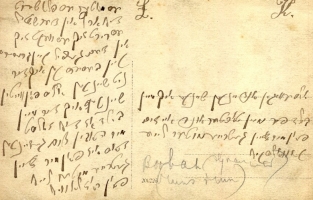 |
|
Leja
Kowalska (née
Linenberg)
Radzilow, c.1920s
Leja
was born in Radzilow c.1853 and married Izrael
Moszk
Kowalski there in 1876. He died in 1900 and she
later re-married his uncle, Mejer Zvi Kowalski, prompting
the emigration of her daughter, Brajna, to London in
1905. Leja died
in Radzilow, 1931
|
Yiddish
inscription reads:
Right-hand side:
"...und
sheine euch mein Bild fur mein Tochter und ihre Zoon
fun mir dein getreire Mutter Leah Kowalski"
"...my picture for my daughter and your husband,
from me, your beloved mother, Leah Kowalski."
Left-hand side:
"Es fut
sich es plutshet sich dem Arzt in dem Shtetl es rirt
sich es wegt sich in dem gefeel kein (or gein)
grubres (?) kein bessus kein euch dir nit sheinken
alles von weiten sheint euch tzur mein Bilt az die
Zolst mir hoben tzum gedenken. Das iz von mir dein
getreire Mutter Leah fun..."
"...in the shtetl it’s moving, it’s waking up in the
feeling of going(?)... no better... not to send
anything from afar... shines... to my picture... you
should have it to remember me. That is from me, your
beloved mother Leah for the..."
English
post-script reads:
"Boobah
(Granmar) (Mums Mum)"
|
|
Photo from estate of Lynda Harvey. Partial
translation by Naftali Lieberman. |
|
|
|
Photo 03-06-07
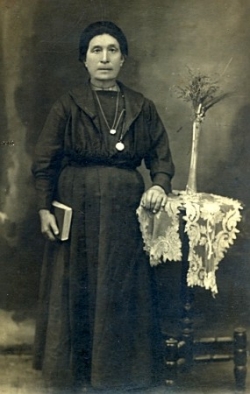
|
|
Leja
Kowalska (née
Linenberg)
Radzilow, 13
October 1922
Inscription on reverse reads: "1922 13/x Radzylaw"
English
post-script reads: "Grandmother Mrs Kovalsky"
|
|
Photo from estate of Lynda Harvey |
|
|
|
Photo 03-06-08 |
|
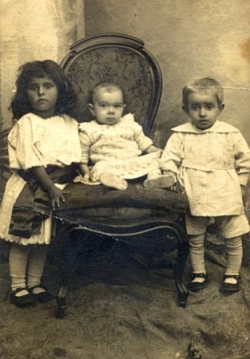
|
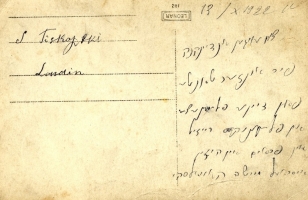 |
|
(left to
right)
Riwka Reizil
Niedzwiecka (later Davidovich)
Izrael Mosze
Kowalski (later Mosze Peled)
Efroim Hersz Niedzwiecki
(later Sharon)
Radzilow, 13
October 1922
Riwka
Reizil emigrated to Israel in 1939.
Izrael Mosze's parents emigrated to Jerusalem with him
c.1924. He became a well-respected academic, and
died in 2001. Efroim spent time in a concentration
camp but survived
and
emigrated to Israel.
|
Yiddish
inscription reads:
"Tzum
evigin andenkenk fur einzer tanta fun deina
plimenitze un plimenikes Reizil un Froim un kuzin
Yisrael Moshe Kovalski"
"As a memento for our aunt from your niece & nephews
Reizil and Froim, and cousin Israel Moshe Kowalski."
The
photo is dated "13/x 1922" and
addressed to "S Tiskofski, Londin" |
|
Photo from estate of Lynda Harvey.
This translation is a combination of translations by Tamara Selden, John
Strauss and Saul Marks. |
|
|
|
Photo 03-06-09
|
Photo 03-06-10 |
Photo 03-06-11 |
|
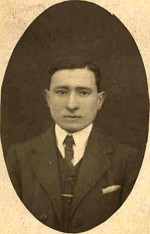
|
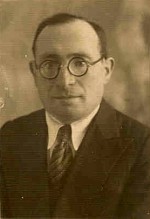 |
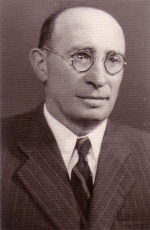 |
|
Radzilow, c.
early 1920s
|
Mejer
Kowalski
Jerusalem, c.1940
|
Jerusalem, c.1947 |
|
Mejer was born in Radzilow c.1892 and ran his late
father's blacksmith's forge in the late 1910s and
early 1920s.
In 1919, he married his cousin, Estera Dwojra
Kaminska. He emigrated with Estera and his son,
Izrael Mosze, to Jerusalem c.1924. He died in
Jerusalem c.1995, aged 103.
|
|
Photos from estate of Lynda Harvey |
|
|
|
Photo 03-06-12
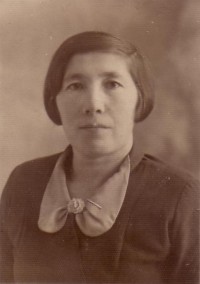
|
|
Estera
Dwojra Kowalska (née Kaminska)
Jerusalem, c.1940
Estera Dwojra was born in Radzilow and was Shim
Kamensky's younger sister. In 1919, she married her
cousin,
Mejer Kowalski, and the couple emigrated to
Jerusalem c.1924, with their baby son, Izrael Mosze.
She died
there c.1962.
|
|
Photo from estate of Lynda Harvey |
|
|
|
Photo 03-06-13 |
|
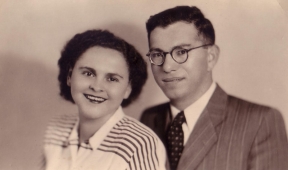
|
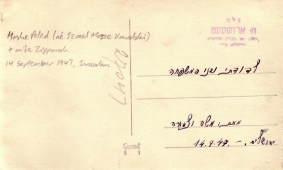 |
|
Moshe Peled and his
wife, Zipporah
Jerusalem, 14
September 1947
Moshe was born Izrael Mosze Kowalski in Radzilow in 1921, and emigrated with his parents to Jerusalem
c.1924.
He became a well-respected academic and died in Jerusalem
in 2000.
|
Hebrew
inscription reads:
"L'dodti
ub'nei hamishpacha
ma'at:
Moshe veZipporah
Yerushalayim - 14.9.47."
"To my aunt and family
From
Moshe and Zipporah
Jerusalem - 14.9.47."
English
caption in pencil is mine
|
|
Photo from estate of Lynda Harvey. Translation by
Avraham Dorogoy and Saul Marks. |
|
|
|
Photo 03-06-14
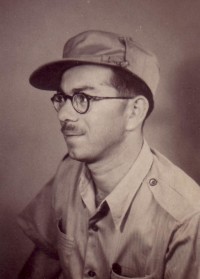
|
|
Moshe
Peled (né Izrael Mosze Kowalski)
Jerusalem, c.1950s
Moshe was born Izrael Mosze Kowalski in Radzilow in 1921, and emigrated with his parents to Jerusalem
c.1924.
He became a well-respected academic and died in Jerusalem
in 2000.
|
|
Photo from estate of Lynda Harvey |
|
|
|